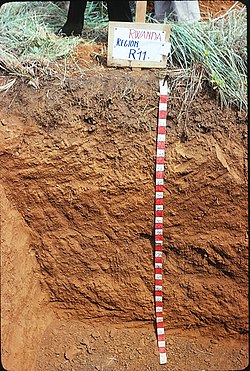Ustic
| Ustic Moisture Regime | |
|---|---|

Ustic Kandihumult
(Fine, Kaolinitic, Isohyperthermic) |
|
| Used in | WRB, USDA soil taxonomy |
| Climate | Semi-arid |
Ustic is a class of soil moisture regime. It is one of a range of different soil moisture regimes, such as: aquic moisture regime, aridic moisture regime, udic moisture regime and xeric moisture regime. The ustic moisture regime is intermediate between the aridic regime and the udic regime.
The ustic moisture regime (Latin: ustus, burnt) applies to soils in which moisture is present, but limited, at times in which conditions are suitable for plant growth. A suborder of Mollisol, the ustic moisture regime is wetter than the aridic moisture regime and drier than the udic moisture regime. For a soil to be classified as ustic, averaged across the year, stored moisture plus rainfall is less than the amount of water lost from the soil via evapotranspiration. The ustic moisture regime is common in semi-arid and sub-humid climates.
There are certain climate conditions which characterises a particular soil as ustic: the soil temperature must be 22 °C (degrees Celsius) or above annually, or winter contra summer soil temperatures must vary by less than 6 °C at a particular depth of 50 cm below the soil surface. The soil moisture control section of ustic soil is dry, in some or most parts, for at least 90 or more cumulative days in a normal year. Ustic soil is also moist, in some parts, for more than 180 cumulative or 90 consecutive days per year.
If the soil temperature is 22 °C and above annually, or if winter contra summer soil temperatures vary by more than 6 °C at a particular depth of 50 cm below the soil surface, the soil moisture control section of ustic soil is dry, in some or most parts, for at least 90 or more cumulative days in a normal year. Although it is not dry in all parts for more than half of these cumulative days, at a soil depth of 50 cm the soil temperature is greater than 5 °C. In the event that the moisture control section is moist in all parts for 45 or more consecutive days in the four months after the winter solstice, the moisture control section is then dry in all parts for less than 45 consecutive days in the four months after the summer solstice.
...
Wikipedia
